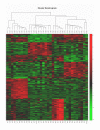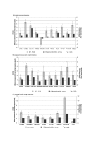Gene expression profiling for molecular distinction and characterization of laser captured primary lung cancers
- PMID: 18992152
- PMCID: PMC2613386
- DOI: 10.1186/1479-5876-6-69
Gene expression profiling for molecular distinction and characterization of laser captured primary lung cancers
Abstract
Methods: We examined gene expression profiles of tumor cells from 29 untreated patients with lung cancer (10 adenocarcinomas (AC), 10 squamous cell carcinomas (SCC), and 9 small cell lung cancer (SCLC)) in comparison to 5 samples of normal lung tissue (NT). The European and American methodological quality guidelines for microarray experiments were followed, including the stipulated use of laser capture microdissection for separation and purification of the lung cancer tumor cells from surrounding tissue.
Results: Based on differentially expressed genes, different lung cancer samples could be distinguished from each other and from normal lung tissue using hierarchical clustering. Comparing AC, SCC and SCLC with NT, we found 205, 335 and 404 genes, respectively, that were at least 2-fold differentially expressed (estimated false discovery rate: < 2.6%). Different lung cancer subtypes had distinct molecular phenotypes, which also reflected their biological characteristics. Differentially expressed genes in human lung tumors which may be of relevance in the respective lung cancer subtypes were corroborated by quantitative real-time PCR. Genetic programming (GP) was performed to construct a classifier for distinguishing between AC, SCC, SCLC, and NT. Forty genes, that could be used to correctly classify the tumor or NT samples, have been identified. In addition, all samples from an independent test set of 13 further tumors (AC or SCC) were also correctly classified.
Conclusion: The data from this research identified potential candidate genes which could be used as the basis for the development of diagnostic tools and lung tumor type-specific targeted therapies.
Figures



Similar articles
-
Are adenosquamous lung carcinomas a simple mix of adenocarcinomas and squamous cell carcinomas, or more complex at the molecular level?Lung Cancer. 2010 Apr;68(1):1-9. doi: 10.1016/j.lungcan.2009.11.001. Epub 2009 Dec 8. Lung Cancer. 2010. PMID: 20004040 Review.
-
Genomic Copy Number Signatures Uncovered a Genetically Distinct Group from Adenocarcinoma and Squamous Cell Carcinoma in Non-Small Cell Lung Cancer.Hum Pathol. 2015 Aug;46(8):1111-20. doi: 10.1016/j.humpath.2015.04.009. Epub 2015 May 6. Hum Pathol. 2015. PMID: 26003479
-
Identification of microRNAs differentially expressed between lung squamous cell carcinoma and lung adenocarcinoma.Mol Med Rep. 2013 Aug;8(2):456-62. doi: 10.3892/mmr.2013.1517. Epub 2013 Jun 11. Mol Med Rep. 2013. PMID: 23759980
-
Integrated classification of lung tumors and cell lines by expression profiling.Proc Natl Acad Sci U S A. 2002 Sep 17;99(19):12357-62. doi: 10.1073/pnas.192240599. Epub 2002 Sep 6. Proc Natl Acad Sci U S A. 2002. PMID: 12218176 Free PMC article.
-
Gene expression profiling reveals reproducible human lung adenocarcinoma subtypes in multiple independent patient cohorts.J Clin Oncol. 2006 Nov 1;24(31):5079-90. doi: 10.1200/JCO.2005.05.1748. J Clin Oncol. 2006. PMID: 17075127 Review.
Cited by
-
The PFA-AMeX method achieves a good balance between the morphology of tissues and the quality of RNA content in DNA microarray analysis with laser-capture microdissection samples.J Toxicol Pathol. 2015 Jan;28(1):43-9. doi: 10.1293/tox.2014-0045. Epub 2014 Dec 19. J Toxicol Pathol. 2015. PMID: 26023261 Free PMC article.
-
HLungDB: an integrated database of human lung cancer research.Nucleic Acids Res. 2010 Jan;38(Database issue):D665-9. doi: 10.1093/nar/gkp945. Epub 2009 Nov 9. Nucleic Acids Res. 2010. PMID: 19900972 Free PMC article.
-
Identification of candidate genes associated with the pathogenesis of small cell lung cancer via integrated bioinformatics analysis.Oncol Lett. 2019 Oct;18(4):3723-3733. doi: 10.3892/ol.2019.10685. Epub 2019 Jul 29. Oncol Lett. 2019. PMID: 31516585 Free PMC article.
-
Tumor protein D52 (TPD52) and cancer-oncogene understudy or understudied oncogene?Tumour Biol. 2014 Aug;35(8):7369-82. doi: 10.1007/s13277-014-2006-x. Epub 2014 May 6. Tumour Biol. 2014. PMID: 24798974 Review.
-
High expression of CASK correlates with progression and poor prognosis of colorectal cancer.Tumour Biol. 2014 Sep;35(9):9185-94. doi: 10.1007/s13277-014-2179-3. Epub 2014 Jun 14. Tumour Biol. 2014. PMID: 24927672
References
-
- Sato M, Shames DS, Gazdar AF, Minna JD. A translational view of the molecular pathogenesis of lung cancer. J Thorac Oncol. 2007;2:327–43. - PubMed
-
- Hirabayashi H, Ohta M, Tanaka H, Sakaguchi M, Fujii Y, Miyoshi S, Matsuda H. Prognostic significance of p27KIP1 expression in resected non-small cell lung cancers: analysis in combination with expressions of p16INK4A, pRB, and p53. J Surg Oncol. 2002;81:177–84. doi: 10.1002/jso.10176. - DOI - PubMed
Publication types
MeSH terms
LinkOut - more resources
Full Text Sources
Medical
Molecular Biology Databases
Research Materials

